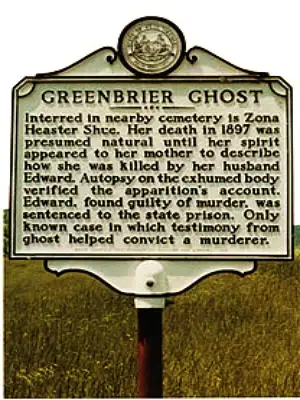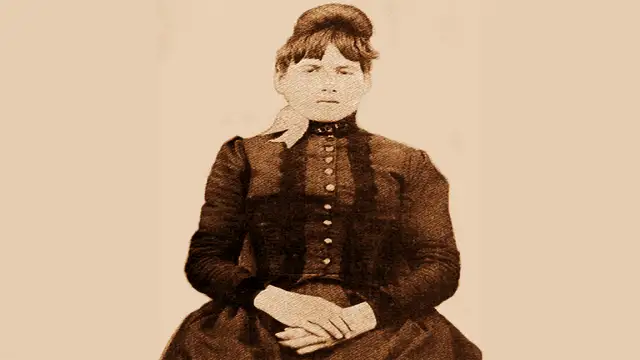In early October 1896, a young woman named Zona Heaster fell in love with Trout Shue, a powerful blacksmith. Zona was just 23, while Trout was 35. Despite her mother’s strong objections, they married just weeks later. Tragically, three months after their wedding, Zona was found dead. Initially, her death was ruled accidental, but whispers of murder lingered. Zona’s mother, Mary Jane Heaster, believed the rumors when Zona’s ghost appeared to her four nights in a row, revealing Trout’s cruelty. This haunting led to an investigation that uncovered the truth about Zona’s death.
Key Details:
- Date: January 23, 1897
- Location: Greenbrier, West Virginia
- Victim: Zona Heaster Shue
- Cause of Death: Strangulation
- Accused: Erasmus Stribbling Trout Shue
The story of Zona’s murder is a ghost tale passed down through generations. While many details vary, some facts remain clear. Zona Heaster was born in Greenbrier County, West Virginia, in 1873. Although often depicted as innocent, she had a child out of wedlock in November 1895. In October 1896, she met Trout Shue at his blacksmith shop and quickly fell for him. They married on October 20, 1896.
Who Was Trout Shue?
Trout Shue, born around 1861 in Virginia, had a troubled past. He had been married twice before. His first marriage to Ellen Cutlip ended in divorce after they had a daughter. His second wife, Lucy Tritt, died less than a year after their marriage. The circumstances of Lucy’s death were unclear, with rumors ranging from an accident to foul play. Trout had also spent two years in prison for stealing a horse. After his second wife’s death, he moved to Greenbrier County to start anew.
The Mysterious Death of Zona Heaster
On January 23, 1897, Zona’s body was discovered at the foot of a staircase by a neighbor boy. Trout had dressed her for burial in a high-necked dress, which raised suspicions. Dr. George W. Knapp examined the body but was disturbed by Trout’s behavior. Initially, he reported the cause of death as “an everlasting faint,” later changing it to “childbirth.” However, if Zona was pregnant, no one knew about it.
Mary Jane Heaster, Zona’s mother, was convinced that Trout had murdered her daughter. She prayed for a sign, and soon, strange events began. After washing a sheet from Zona’s coffin, the water turned red, and the sheet became stained pink. About a month after Zona’s death, Mary Jane began having visions. Zona’s ghost appeared to her, revealing that Trout had abused her and broken her neck during an argument.
The Investigation Begins
Mary Jane took her story to prosecutor John Alfred Preston. Although he was skeptical about reopening the case based on a ghost story, he began to ask questions. Dr. Knapp admitted his examination was incomplete and mentioned seeing bruises on Zona’s neck. Neighbors reported Trout’s odd behavior at the wake, where he kept a close watch on the coffin and prevented anyone from examining the body closely.
Authorities decided to exhume Zona’s body for a thorough autopsy. The results were shocking: her neck had been broken, dislocated between the first and second vertebrae, and her windpipe was crushed. This evidence led to Trout Shue’s arrest for murder.
The Trial of Trout Shue
The trial began on June 23, 1897. The roadside marker for the “Greenbrier Ghost” claims it is the only case where ghost testimony helped convict a murderer. However, this is an exaggeration. Prosecutor John Preston did not mention Mary Jane’s ghost story in court, knowing it wouldn’t be admissible. Trout’s attorney, William Rucker, tried to discredit Mary Jane during cross-examination, but it backfired. The jury was not swayed.
The trial lasted eight days, and while the evidence was circumstantial, it was compelling. On the sixth day, Trout took the stand in his defense. His testimony did not impress the jury, and they deliberated for just over an hour before finding him guilty of first-degree murder. Although ten jurors voted for execution, the verdict was not unanimous, so Trout was sentenced to life in prison.
Aftermath and Legacy
The life sentence angered many in Greenbrier County, who believed Trout deserved to hang. On July 11, 1897, an armed mob gathered to lynch him. However, Sheriff Nickell learned of the plot and hid Trout in the woods before confronting the mob. He persuaded them to disperse, and four members were later indicted for attempted lynching.

On July 13, 1897, Trout Shue was transferred to the state penitentiary in Moundsville, West Virginia. He lived there until his death on March 13, 1900, from natural causes. The case of Zona Heaster Shue remains a haunting tale, blending elements of tragedy, mystery, and the supernatural.
The Impact of the Greenbrier Ghost Story
The story of the Greenbrier Ghost has captivated people for generations. It raises questions about love, betrayal, and the lengths to which a mother will go to seek justice for her child. The case is often cited in discussions about the intersection of folklore and legal history. It serves as a reminder of how powerful stories can shape our understanding of events, even when the facts are murky.
Mary Jane Heaster’s insistence on the truth of her daughter’s death, combined with her ghostly encounters, highlights the deep emotional ties between a mother and her child. Her determination to uncover the truth ultimately led to a significant legal outcome, even if the ghostly testimony was not formally recognized in court.
Cultural Significance
The Greenbrier Ghost story has become a part of West Virginia folklore. It is often referenced in books, documentaries, and ghost tours in the area. The tale serves as a cautionary reminder of the potential for domestic violence and the importance of listening to the voices of victims, even when they are no longer present.
In addition, the case has inspired various artistic interpretations, including plays and novels, which explore the themes of love, loss, and the supernatural. The story resonates with those who believe in the power of the spirit world and the idea that the dead can communicate with the living.
Modern Perspectives
Today, the Greenbrier Ghost story is often examined through a modern lens. Scholars and enthusiasts analyze the case for its historical context, exploring the societal norms of the late 19th century regarding marriage, gender roles, and the treatment of women. The story also raises questions about the reliability of eyewitness accounts and the influence of folklore on legal proceedings.
In recent years, there has been a resurgence of interest in ghost stories and paranormal investigations. The Greenbrier Ghost remains a popular topic among those fascinated by the supernatural. It serves as a reminder that some stories endure, evolving over time while still holding a kernel of truth.
Conclusion: A Tale of Love and Loss
The tragic story of Zona Heaster Shue and the Greenbrier Ghost is a powerful narrative that intertwines love, loss, and the quest for justice. It highlights the complexities of human relationships and the impact of violence on families. While the ghostly elements may seem fantastical, they underscore the very real emotions and struggles faced by those left behind.
As we reflect on this haunting tale, we are reminded of the importance of seeking truth and justice, even in the face of overwhelming odds. The legacy of Zona Heaster Shue lives on, not just as a ghost story, but as a testament to the enduring bond between a mother and her child.

